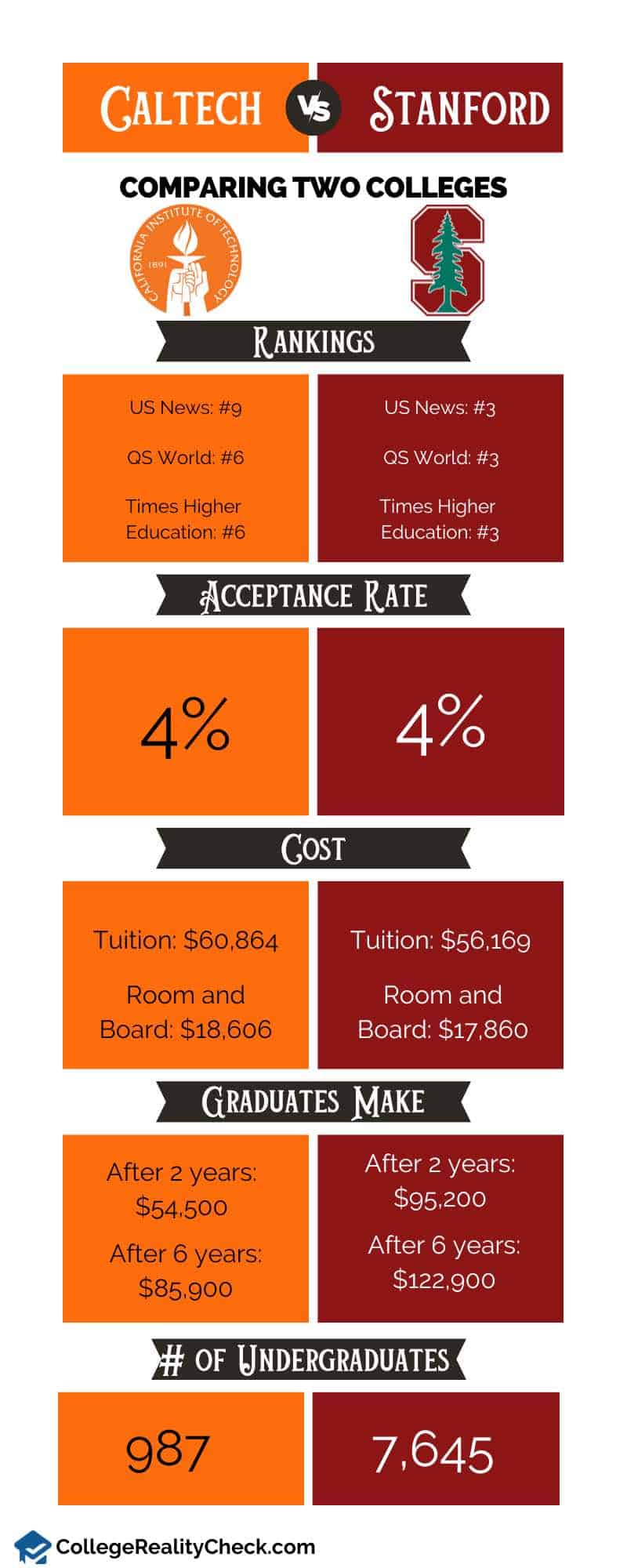Choosing the Best: Stanford vs. Caltech
Technically, Stanford University and the California Institute of Technology (Caltech) are not Ivy League schools. But because they have the same reputation, both are considered Ivy Plus institutions.
Highly selective — this is another thing that they have in common.
Stanford, which is a private research university located in Stanford, California, is known for liberal arts, law, medicine and engineering. On the other hand, Caltech, which is also sometimes known as CIT and is a private research university located in Pasadena, California, is popular for science and engineering.
Planning on putting either Stanford or Caltech at the top of your college list? Make sure that you read this post until the very end to have a much better idea of the key differences between these dream schools of many graduating high schoolers.
The founding dates of Stanford University and Caltech are just 6 years apart.
From the get-go, Stanford, whose official name is Leland Stanford Junior University, has been a university.
While it was founded in 1885 by Leland and Jane Stanford, it was only in 1891 that it opened its doors for the first time to degree-seeking students — there were 555 of them. During that time, Stanford was located in Palo Alto.
Caltech, meanwhile, was founded in 1891 as a vocational school. Back then, it was known as Throop University, whose name came from its founder, Amos G. Throop, who was a local businessman and politician.
The institution changed its name several times throughout its history — it was named the California Institute of Technology in 1920.
Stanford and Caltech in College Rankings
Both Stanford University and Caltech are some of the most highly-ranked degree-granting institutions in the land.

US News ranks Stanford #3 in National Universities. Meanwhile, it ranks Caltech #9 in National Universities. US News also ranks global universities.
For the popular college ranking site’s Best Global Universities, as expected, both prominent American schools are included — Stanford is #3, while Caltech is #9.
Times Higher Education (THE) is a trusted site when it comes to international university rankings.
For its World University Rankings, which includes 1,799 institutions across the globe, Stanford is #3, a spot that it shares with the University of Cambridge located in the UK. Caltech, on the other hand, is #6.
Another reliable ranking site of universities all over the planet is QS World University Rankings. QS ranks Stanford #3. On the other hand, it ranks Caltech #6, a spot that Imperial College London in the UK also occupies.
Admission
Here’s a reason why Stanford University and Caltech are commonly mistaken as Ivy League schools: they have very low acceptance rates. As a matter of fact, as of this writing, both institutions accept only 4% of all applicants.
They share the same single-digit acceptance rate with Harvard University, which is an actual Ivy League.
Needless to say, you need to be an above-average high school student to enjoy increased acceptance to them.
Based on the most recent Common Data Set (CDS), as of this writing, of these top-notch schools, 75.1% of Stanford admits and 90.77% of Caltech admits graduated in the top 10% of their high school class.
Based on data provided by College Simply, which is a college ranking site just like US News and the rest, students accepted to Stanford and Caltech have an average high school GPA of 3.96 and 3.97, respectively.
Stanford is one of those test-optional institutions where applicants may or may not submit their test scores. But just for you to have an idea, admits who submitted theirs had SAT scores of 1470-1570 and ACT scores of 34 to 35.
On the other hand, Caltech has a test-free or test-blind admissions policy.
Majors and Programs in Caltech and Stanford
Stanford University has 67 majors. At the prestigious school, undergraduate students must declare a major by the end of their sophomore year. However, they can choose to do so anytime from first to second year.
Here are some of the most popular majors at Stanford:
- Computer and information sciences and support services
- Engineering
- Social sciences
- Mathematics and statistics
- Physical sciences
- Biomedical sciences
- Psychology
- Area, ethnic, cultural, gender and group studies
At Caltech, meanwhile, students who are undergraduates are required to declare a major by the end of their freshman year — everyone at the elite school takes the same classes during their first 2 semesters. Those who are working on a bachelor’s degree may choose from 28 majors, which are spread across 6 academic institutions.
The following are some of the most popular majors at Caltech:
- Computer and information sciences and support services
- Engineering
- Physical sciences
- Mathematics and statistics
- Biomedical sciences
- Astronomy and astrophysics
Cost of Attendance
Based on the rate for the previous academic year, it’s cheaper to attend Stanford than Caltech.
The estimated cost of tuition and fees at Stanford University is $56,169. On the other hand, the estimated cost of tuition and fees at the California Institute of Technology is $60,864.
When considering attending either Stanford or Caltech, remember to take the cost of room and board into account — all freshmen students are required to live on campus at the start of their college career.
However, undergraduates at Stanford are required to live on campus for their first year, while Caltech undergraduates are required to live on campus for their first 2 years.
Room and board cost at Stanford is $17,860 per year. At Caltech, it’s $18,606 per year.
Around 48% of first-year students attending Stanford receive need-based aid. Each one, on average, receives $62,500. On the other hand, about 57% of first-year students at Caltech receive need-based aid, averaging $60,172 each.
Campus Comparison
The suburban campus of Stanford University measures 8,180 acres. Caltech’s campus, which has a suburban setting, is much smaller than Stanford’s — it’s just 124 acres in size.
Despite this, the campus of Caltech is ranked by Niche #38 in Best College Campuses in California and #511 in Best College Campuses in America.
On the other hand, the same college ranking site ranks the campus of Stanford #5 in Best College Campuses in California and #26 in Best College Campuses in America.
Population and Diversity at Stanford and Caltech
As of this writing, the entire student population of Stanford University is 17,680 — 7,645 or 43.24% of them are working on an undergraduate degree. Meanwhile, Caltech has a grand total student population of 2,397, which is considerably smaller than Stanford’s population. Among its attendees, only 987 or 41.18% are undergraduate students.
When it comes to retention rate, Caltech is the winner by a small amount — 99.11% vs. 98.3%.
Both Stanford and Caltech have diverse campuses. As a matter of fact, around 72% of students attending Stanford are from minority groups. Meanwhile, the percentage of minority groups at Caltech is 65%.
Let’s compare the ethnic diversity of these elite schools:
Stanford vs. Caltech: How Much Graduates Make
Two years after graduation, alumni members of Stanford who are employed make an average of $95,200 per year. The amount of money they make climbs to $122,900 per year, on average, after six years.
Employed alumni members of Caltech make, on average, around $54,500 per year 2 years after graduating from the elite institution. On the other hand, the amount of money they make per year climbs to $85,900, on average, after about 6 years from the time they graduate.
Just Before You Choose Between Stanford and Caltech
Both Stanford University and the California Institute of Technology are prestigious and selective institutions.
As a matter of fact, they are considered Ivy Plus schools and have the same low 4% acceptance rate. And, more importantly, both schools are popular for their undergraduate engineering programs.
Since they have many things in common, you may have to base your choice on some factors that you deem more important, such as the cost of attendance and campus diversity.
Read Also:
- Stanford vs. Harvard
- MIT or Stanford
- Stanford vs. Yale
- Colleges Similar to MIT and Stanford But Less Competitive
Disclaimer: The views and opinions expressed in this article are those of the authors and do not necessarily represent those of the College Reality Check.





